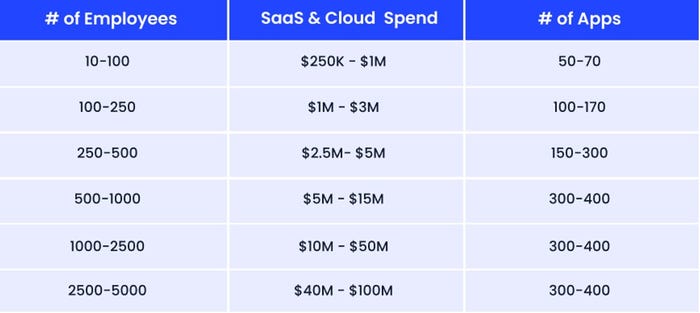Overspending on SaaS? 6 Ways to Cost Optimization
Here are 6-step quick tips to optimize your SaaS spending. Applying these tactics in your organization can reduce your SaaS expenses without adversely impacting your bottom line.
December 5, 2023

SaaS applications have transformed the way businesses operate. From cloud-based productivity tools to cutting-edge CRM, sales, and marketing platforms, SaaS solutions offer unique convenience and scalability.
Yet, this convenience often comes with a price, and many organizations are facing the challenge of overspending. The attraction of new features, flexibility, and options has led to uncontrolled SaaS purchases, resulting in SaaS sprawl. This continues to cause problems for organizations, leading to less-than-ideal returns on investment and management hassles.
Our SaaS spend report revealed that software spend is now the third highest in organizations, following employee and office spend. Some of the factors causing overspending include:
Shadow IT: Purchasing and using applications by employees without the approval of IT, leading to hidden costs that are complex to track without a sophisticated SaaS management system.
Purchasing beyond the need: Typically, organizations forecast their growth and acquire excess licenses that surpass their actual needs. Consequently, many of these licenses remain unused, leading to suboptimal ROI and unnecessary expenditures.
Lack of application and spend visibility: Finance and IT teams will be unaware of the application usage without complete visibility. Users might have stopped using the app, but the finance team could renew the contract without realizing it.
Missed renewals: Inadequate spend visibility and the use of spreadsheet-based tracking will lead to missed renewals. Additionally, shadow IT applications often trigger automatic renewals, increasing expenses.
Lack of price benchmarking: Lack of awareness about what your peers pay for similar applications may result in overpaying for licenses.
6 Ways to SaaS Cost Optimization
1. See where you’re overspending
Before starting with cost optimization, you must first analyze where you’re overspending. Start with a thorough spend analysis using a spend management platform. Identify all your SaaS applications, licenses, associated costs, and the ROI they generate.
A spend management platform can automatically categorize apps into used, unused, and redundant applications, making it easier for you to eliminate them and increase SaaS savings.
How much do you think your peers are paying for SaaS apps?

SaaScosts.jpg
Compare the latest benchmarks and analyze whether you pay higher or lower than your peers. If you’re paying higher, then follow the next step for a quick savings opportunity.
2. Consolidate into one application
One of the quickest ways to optimize your SaaS costs is by eliminating redundancy. In many organizations, different teams use multiple applications that perform similar tasks.
For instance, the Marketing, Sales, and Engineering teams might each utilize separate applications for instant communications. In these cases, consolidation is the key. By consolidating these overlapping applications into a unified, full-stack solution, you're streamlining your operations and significantly reducing your overall spending.
3. Eliminate unused Licenses
Many organizations purchase surplus licenses to accommodate projected growth. However, this often results in underutilization and a poor return on investment. Analyze license usage to identify underused licenses and reallocate them or reduce surplus licenses during renegotiations to save on spending.
You cannot track licenses through spreadsheets or utilize a SaaS management platform to get accurate license usage insights. Create workflows to reclaim unused licenses and reallocate them automatically.
4. Automation is the key
Auto-renewals can be frustrating. As long as organizations use manual renewal tracking methods, they won’t be able to prevent auto-renewals. Leverage automated workflows from SaaS management platforms, get timely reminders, and renew your contracts on time.
IT and finance teams will have enough time to analyze usage and price benchmarks. Armed with this data, the procurement team can efficiently negotiate with the vendors to right-size licenses based on usage and optimize spend based on the benchmarks.
5. Prevent shadow IT
Shadow IT is one of the major driving factors of SaaS spend. Get complete visibility over your SaaS stack using a SaaS management platform and set up alerts whenever an unsanctioned app is detected in your system to prevent shadow IT proactively. Offer users a sanctioned app catalog to prevent independent purchases, ultimately curbing cost escalation.
6. Streamlined Procurement Process
In most cases, having a world-class procurement process will help you have complete control over your purchases and spending.
Ensure that all purchases follow a centralized process, educate your team on their importance, and establish policies that support cost optimization. Transitioning from manual procurement to automated workflows enhances transparency and prevents unauthorized purchases.
Bonus: SaaS Budgeting
To ensure long-term cost optimization, focus on SaaS budgeting. Get complete visibility, analyze usage, understand the requirements, and allocate your budget accordingly to applications and teams in need.
Set budget limits for each department, conduct regular budget audits, and harness and reallocate budgets whenever necessary. This proactive approach keeps your SaaS spending in check and prevents last-minute budget crises.
In conclusion, this quick 6-step playbook will help optimize your SaaS spending. Many CIOs and CFOs successfully use these strategies to cut their software costs by as much as 30%. Applying these tactics in your organization can reduce your SaaS expenses without adversely impacting your bottom line.
Nidhi Jain is the CEO and Co-founder of CloudEagle.
Related articles:
About the Author
You May Also Like




